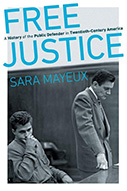Free Justice: A History Of The Public Defender In Twentieth-Century America

Author: Sara Mayeux
Publisher: Chapel Hill, NC: The University of North Carolina Press, 2020. 271p.
Reviewer: Sam Bieler | September 2021
Public defenders’ stock is at an all-time high. Widely celebrated as opponents of mass incarceration and lauded for their selfless efforts battling injustice, it is difficult to imagine otherwise. Yet, as Sara Mayeux shows in Free Justice: A History of the Public Defender in Twentieth-Century America, this love affair is the most recent of phenomena. For most of the legal profession’s history, the criminal defense lawyer, public or private, was one of the law’s least prestigious callings. At the opening of the 1900s, the very idea of a public defender was mocked and attacked as a harbinger of socialism. By the close of the century, the idea of the public defender was widely accepted yet the defenders themselves were under-resourced and occupied an uncertain role in the public sphere. Free Justice chronicles this difficult birth and journey in an entertaining and descriptive work that all readers, and particularly lawyers of all stripes, will find valuable.
Mayeux’s story is about a failure of imagination: the failure of elite American lawyers to understand the changing nature of society and how the public defender might rise to meet its needs. The failures began early in the 1900s with the first calls for public defenders. The concept of publicly funded defense lawyers was first raised by an eclectic collection of legal outsiders like Mayer Goldman and Edward Bellamy. Its first opponents were elite lawyers who feared the intrusion of government into their self-regulated profession. The legal elite simply did not believe that in the loud, disorderly, and often disreputable field of criminal defense, people needed a lawyer to be treated fairly by the government. One telling 1915 survey of judges and district attorneys issued by the Association of the City Bar of New York insisted that impoverished, lawyer-less defendants suffered no disadvantage in court. And, even if they did, elite lawyers insisted that a public defender was simply not viable because they could not truly be an independent advocate for their client on the government dime. Even advocates for a public defender were divided about what these lawyers would do. Some imagined a pure client advocate, a publicly paid version of the private defense lawyer. Others, particularly in the Progressive movement, envisioned a collaborative figure who would work both against and with the government to get to the truth of a matter and dispense justice accordingly.
By the Cold War, the paradigm had shifted. America’s battle with the Soviet Union made the public defender a way for the U.S. to differentiate itself from its opponents. Communists gave criminals show trials; America gave them lawyers. The public defender’s acceptability culminated in the 1963 Supreme Court decision, Gideon v. Wainwright, which made counsel mandatory for those faced with most criminal charges. The support of elite lawyers had advantages: the right to counsel would never again be seriously questioned. Even during the Reagan years, the right to counsel would survive the rollback of other legal rights created by the Warren Supreme Court.
Yet while the legal profession now agreed there should be defenders, they disagreed on their role. The elite position, which eventually carried the day, was that defenders would be like them, independent lawyer-advocates who just happened to be paid by the government. They gave little thought to whether such a model would be effective, assuming that once the lawyers guaranteed by Gideon were in place, the profession would handle whatever challenges came their way.
But whether or not such a model could be effective, it quickly became clear that in practice, the defender would struggle to meet their clients’ needs. Gauzy assumptions that simply giving people a lawyer would effectively vindicate their rights began to collapse throughout the 1970s and 1980s, as caseloads rose and defender offices were implemented with varying degrees of enthusiasm. Now-familiar critiques of the public defender as an overworked, undermotivated deal-maker just looking to secure the quickest plea began to surface. Racial tensions between often-white public defenders and their black clients began to surface, and the defender’s reputation suffered accordingly.
In this, Free Justice resembles and parallels David Halberstam’s classic recounting of the Vietnam War, The Best and the Brightest. Both tell the story of an elite tied to preconceived notions of the world and their profession’s place in it — notions they cling to even as the facts on the ground move further and further away from that idealized world. Both stories also end in disaster: the U.S. is forced out of Vietnam, while defenders were left without the resources or guidance to navigate the eventual crush of cases that would lead to mass incarceration.
Thus, while Free Justice is a history of the public defender, it is also a history of the legal profession that any lawyer will be able to enjoy. Elite positions with respect to public defenders develop alongside the transformation of the profession from the leisurely corporate advisory sinecures of the 1910s and 1920s into the aggressively competitive and business-focused practices that emerged in the 1980s, and that dominate the profession today. The decision to tell these two stories together is a wise one.
Throughout, Free Justice is expertly held together with Mayeux’s skill as both a researcher and writer. Her sources are richly diverse. She explores the key cases supporting the development of the defender, Gideon, Argersinger, Strickland, and Polk, with enough detail to be descriptive, but not so much that legal doctrine sidetracks the narrative. But she also goes beyond cases. Her sources include the pamphlets and books of the Progressive reformers who first gave life to the idea of the defender, as well as the bar association reports and foundation reports that document the elites’ efforts to come to grips with the concept of the defender. She completes the picture with the accounts of public and private defense lawyers who spent their days on the front lines. Together, these sources provide as full and fair-handed a picture of the defender’s inception as could be hoped.
Despite the array of materials, Mayeux’s narrative never becomes too tiresome to push through or too cumbersome to comprehend. A firm believer in “show, don’t tell,” she evocatively describes how early criminal defense lawyers are not merely disfavored, they are disparaged as “Tomb Runners”, flitting through the cramped halls of New York’s “Tombs” holding facility, trading favors with corrupt guards. Sure, a judge tells a young public defender in Boston, you can file an appeal, but if so, the penalty will go from three years’ probation to two years’ imprisonment, with bond set at $5,000! Stories like this put the reader in the middle of the action as the great debates about the role of the public defender were held in the conference rooms of elite lawyers and the courtrooms of America. They keep the action moving and invest the reader in the development of the defender that exists today.
If one thing is missing, it is a compelling case for what the public defender could have been rather than what it became. The elites’ vision of the defender as an independent advocate battling the government is deeply entrenched in the profession’s ethos. It also appeals to many in the field – federal defender Bill Brockett once described one of the great pleasures of his job as “f**king the U.S. Attorney.” A fully fleshed-out alternative to this model is hard to discern. The closest it gets is the vision of the early Progressives, who proposed a collaborative, fact-finding model of criminal justice where prosecutors and defenders work together to discern the truth in a case. This model disappears quickly, and by the latter half of the book is not a serious alternative to the adversarial model, even though many developed countries today use a somewhat comparable “inquisitorial” system to process criminal cases. Similarly, “holistic defenders,” lawyers who also provide other community services, are less an alternative to the elite vision than a supplement. While they provide non-criminal services, these defenders still serve as aggressive, client-focused advocates.
A reader may thus be left wondering today if there is an alternative to the elite vision of a lawyer as an independent advocate. It is fine to say that the public defender should not be or even aspire to the same model of lawyering as do the members of the legal elite, but it would be easier to support this conclusion if the reader knew what else they could be.
If, however, Free Justice is not a complete account of what the public defender could or should have been, it is an outstanding account of what the defender became and how it got there. In telling this story, Mayeux also provides an exceptional account of the growth and evolution of the practice of law in America — one that any lawyer interested in the history of their profession should read.
Sam Bieler worked as a criminologist at the Urban Institute’s Justice Policy Center from 2012 to 2016 and lives in New York City.


